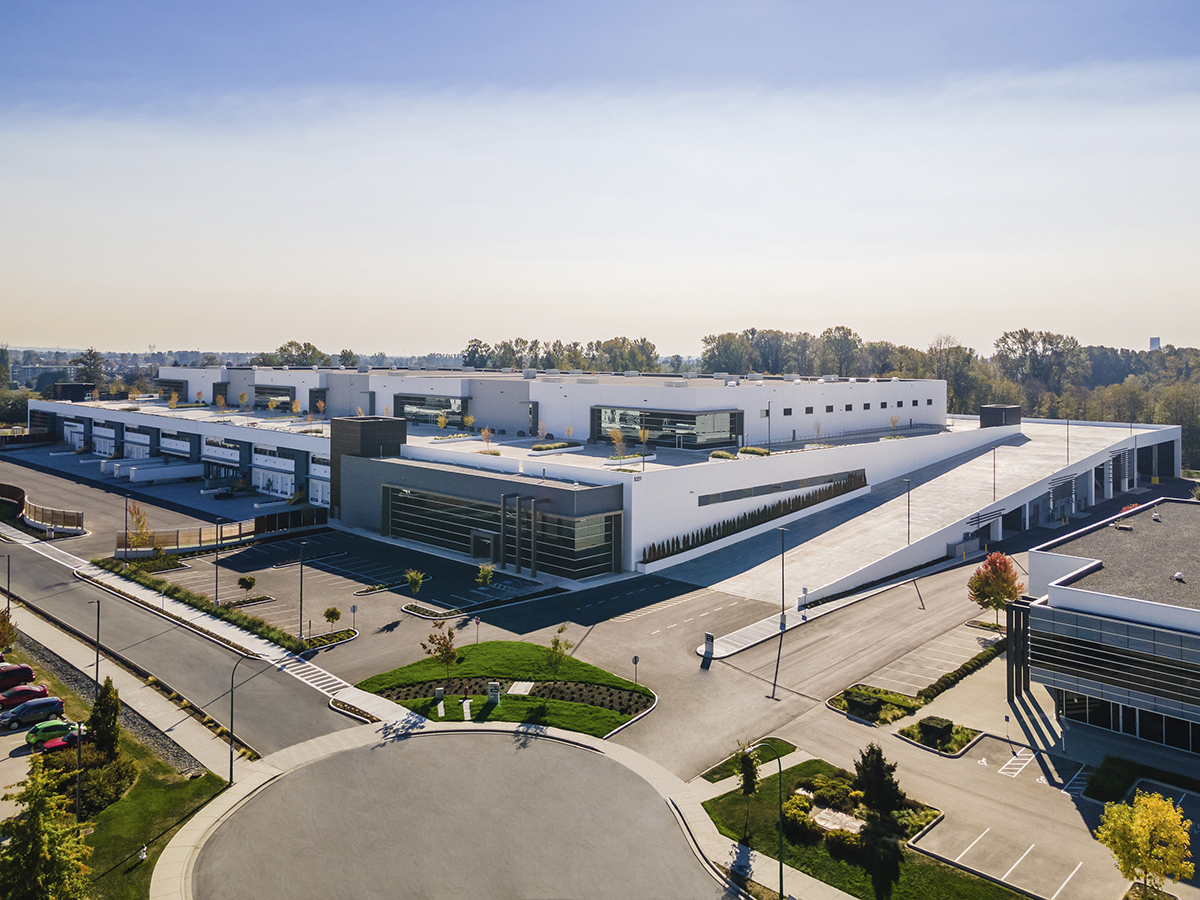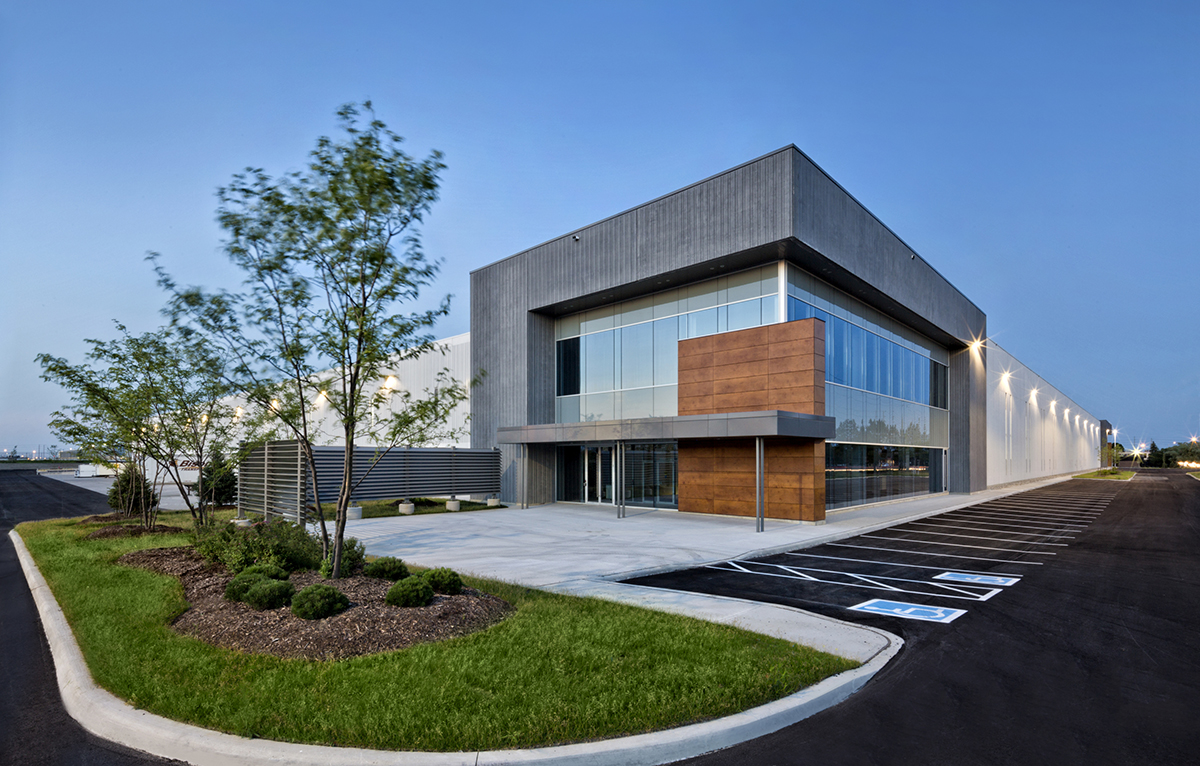[ad_1]
Until recently industrial workplaces were valued for their efficiency and productivity. With experts stressing how buildings equipped with thoughtfully designed, human-centric amenities can promote productivity and foster a healthy work environment, however, added comforts and conveniences are making their way into industrial and warehouse space, too.
Thoughtfully implemented amenities implementation into facilities help reduce burnout, minimizing turnover rates, mitigating workplace stress and boosting overall morale. But, despite how important designing for the health and safety of industrial workers is, the conversation is just now gaining momentum.
“Industrial was historically considered a functional product type, focused on the products and processes in place to manufacture and/or distribute goods,” Cameron Trefry, regional vice president at Ware Malcomb, told Commercial Property Executive. “It was not typically focused on people—which has drastically changed for the better. Overall, there is now more emphasis on designing employee-centric facilities in addition to the building’s efficiency.”
READ ALSO: Manufacturing Thrives Amid Construction Surges
Historically, industrial and manufacturing facilities predate the office building. The first amenities, such as the coffee break room and workplace cafeterias, were all started in industrial workspaces, pointed out Jessica Vessel, senior architect & designer, Burns & McDonnel.
Yet somewhere down the line, innovation in the sector seems to have gotten lost. This has been especially apparent in the face of remote work and massive office vacancies where office amenities have been in the spotlight.
“Talking about industrial amenities may not be as attractive to public conversations as office amenities are but I don’t see a reason why they can’t be,” Vessel observed.
The discussion of industrial amenities and safety for factory employees is not entirely new. Following the Triangle Shirtwaist Factory fire, an industrial disaster that took place in New York City in 1911 and claimed the lives of 146 garment workers, legislation and conversation about industrial safety gained traction. Now, more than a century later, industrial amenities are becoming a more frequent topic of conversation, not only as they pertain to the physical wellbeing of employees but also to their mental wellbeing.
“With the advent of social media, and especially in the wake of the pandemic, you’re allowed to talk about mental health now,” Vessel said. Considering the conversation about physiological wellbeing is no longer as taboo, it’s time to deep dive into what that means for the industrial space.
Following the loss of some 1.4 million manufacturing jobs at the onset of COVID-19, industrial companies have been struggling to maintain their workforce numbers, according to a report by the U.S. Chamber of Commerce. However, with continued strong performance and solid fundamentals, industrial is moving forward. The idea of big box industrial buildings is simply no longer feasible, Trefry said.

Making an industrial facility easily accessible via car and public transportation and having well mapped out amenities is absolutely essential for a facility’s employees. Image by Luke Potter courtesy of Ware Malcomb
Refreshing the bare necessities
The basic amenities are what many developers and industrial experts would rather refer to as the absolute bare minimum. For example, having clean air, property safety equipment, accessible restrooms, dedicated lunch spaces and a place to sit down during breaks are all must-haves. To really take it a step further and make sure it is an amenity as opposed to a necessity, industrial facilities need to implement infrastructure focused on the employee.
READ ALSO: The Rise of Co-Warehousing: What’s the Appeal?
“We know that there are basic needs and then there is the next level up which is: What will bring extra joy and the ability to have some fun, build connections and blow off steam?” said Meaghan Elwell, president, industrials division of JLL Work Dynamics.
There is a whole slew of ideas being implemented into facilities today. “Some of the common outdoor amenities include patios and walking paths around the park,” added Trefry. “On the inside of the facilities amenities can include fitness centers, relaxation zones—an elevated break room for employees to rest and recharge—and kiosks where team members can use computers to get online.”
There are overarching concepts, such as cleanliness, warmth and access to nature that need to be present in all industrial settings, Vessel told CPE. But industrial can take it a step further. “How can we offer unique benefits? Can a refrigeration facility offer workers a sauna or red-light therapy?”
When it comes to mental health, there is no blanket solution for improving it. Ultimately, it is facility by facility and work environment by work environment. For employees conducting hard manual labor, having access to massage chairs in their rest areas could be a huge physical and mental relief. If there isn’t room for a cafeteria, Vessel recommends at least having a snack bar that offers healthy options such a vegetables, fruits and free coffee.
Where there is opportunity to implement highly impactful and uniquely specific spaces there, is also opportunity to elevate the basics. For example, spending extra money on highly-overlooked restroom spaces is crucial.
“If you could provide a wonderful restroom experience for employees that offers full privacy and clean, beautiful finishes, that can make a huge impact on worker satisfaction,” said Vessel.
Even a small or medium-sized break room can have a vast impact on employee mental and physical wellness, especially when it comes to building community. “We’ve got to be sure that we’re taking good care of our people and creating those opportunities for connection,” said Elwell. “Collaboration and innovation and all the things that come from that.”
Break rooms offer a place for interactions that build camaraderie. “Oftentimes these team members are working in challenging environments, so for them to have a baseline of being physically and psychologically safe on top of being connected with each other and part of one larger team goes a long way,” Elwell pointed out.
READ ALSO: The Big City Rebound and Its CRE Implications
It is also important to map out the amenities, said Craig Meyer, JLL President for the Americas, industrial brokerage. “For example, when an employee comes in and has young children, where is the nearest daycare and how fast can they pick them up after work?” said Meyers. “Make certain that you sit down with local transportation authorities and, if you have a building of substantial size, request a dedicated bus stop. These are big differences when you think about employees working there.”
While these amenities are not necessarily directly related to an individual building, they are a responsibility to investigate when planning a large-scale business park, Meyers added.

Having outdoor green spaces where employees can enjoy some fresh air or take an outdoor break can greatly increase psychological wellbeing. Image by Philip Castleton courtesy of Ware Malcomb
Designing and redesigning for amenity spaces
Some amenities that are relatively easy to add but still make a big impact are those that can be renovated and created in small phases and potentially allocated as part of the annual capital expenditures to the physical improvements of the property, noted Frank Di Roma, regional vice president at Ware Malcomb.
“Perhaps the first year an outdoor patio is added, and a fitness center the next,” he said. “Another option is to convert underutilized space in the facility to some of the amenities described, such as taking unused office space and designing a relaxation zone.”
Increasing site branding and signage can boost the aesthetics of a property and strengthen a connection between company culture and its employees. This ultimately can create a sense of belonging.
“For a second-generation building, hire an architect,” Meyers reasoned. “Look at how you can reconfigure bathrooms and add things like air conditioning. Can you forsake a parking spot or take an area out of that building and create some outdoor space?”
For new developments, the employee-centric amenities that are viable to integrate are of abundance. Some of these are much more difficult to create post-development completion.
“By collaborating with an experienced architect and site planner from the onset, amenities such as walking paths can be seamlessly incorporated into the design of the site in larger industrial parks, whereas this amenity would be expensive, and often unfeasible, to add after the facility is built,” said Trefry.
Vessel believes another crucial element in the development of new industrial projects is the integration of local and company culture. If a building is too small to house its own amenities, larger industrial developments can build one centralized hub with various lounges, games etc.
On the other hand, if amenities are being created in one larger facility, new developments should focus on making walking corridors large, well-lit and safe. To integrate local community and culture, some industrial developments are hiring local muralists to paint the facility’s exterior and site.
Building a better future
“Similar to other sectors, the industrial labor market is faced with a tight labor pool,” said Di Roma. “Amenitizing industrial facilities is important to help attract and retain workers and tenants.”
Amenities can also further the future adaptability of buildings, extending the lifespan of industrial parks and increasing their future relevance. “Due to the increase in demand for warehousing and industrial spaces, there is more competition to retain and attract employees at all levels,” he added.
But industrial amenities are not yet at their full potential. “As we have more worker density, we are going to see more office-like building amenities,” said Meyer. What is crucial down the line, he continued, is that as these amenities become more readily available throughout industrial facilities, they are readily available to all employees.
“We’ve got to make sure that we’re providing amenities that are applicable to all people,” Elwell also said. “This means thinking about where the women’s room is and having gender-neutral bathrooms. Those are things that that I think we haven’t quite gotten to in the industrial space but that’s the leading edge. We’ve got to be sure that all diversities are acknowledged.”
Vessel sees amenities as a critical component of U.S. industrial real estate’s next frontier. “Cities were built around these facilities for so long,” said Vessel. “I just want to make sure that we’re providing good work environments so that we can really make American manufacturing exceptional again.”
Read the September 2023 issue of CPE.
[ad_2]
Source link



